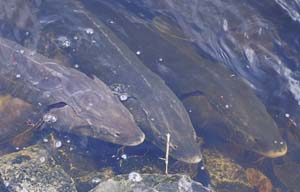Let’s face it, most fish and wildlife volunteers pull weeds or help stock fish. That’s why it’s always fun to read about unique volunteer opportunities. In Wisconsin, one of those opportunities is to serve as a Sturgeon Guard for spawning lake sturgeon in the Wolf River and its tributaries, the Embarrass and Little Wolf Rivers. The volunteers serve 12-hour shifts with a partner, and get a front row seat for the sturgeon spawning spectacle, which features females five- to seven-feet long, and their many male suitors cavorting in shallow water.
The program has eliminated sturgeon poaching in the area, and, apparently, some volunteers are disappointed when their 12-hour shift is cancelled because it falls outside of the actual sturgeon spawning window. Shifts run from April 15 to May 5.
Read more on the Wisconsin Department of Natural Resources website here. A direct link to the Sturgeon Guard program is here. Or read this article on the guard from a 2006 issue of Wisconsin Natural Resources Magazine.
Photo: Lake sturgeon, Eric Engbretson, US Fish & Wildlife Service

